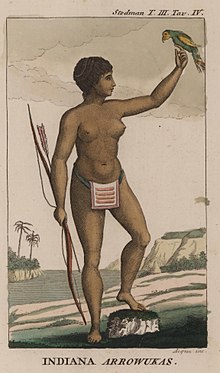Arawak people

Arawak woman, by John Gabriel Stedman
|
|
| Languages | |
|---|---|
| Taíno |
The Arawak are a group of indigenous peoples of South America, Florida, and historically of the Caribbean. Specifically, the term Arawak has been applied at various times to the Lokono of South America and the Taíno, who historically lived in the Greater Antilles and northern Lesser Antilles in the Caribbean, all of whom spoke related Arawakan languages.
The term Arawak originally applied specifically to the South American group who self-identified as Arawak, Arhuaco or Lokono. Their language, the Arawak language, gives its name to the Arawakan language family. Arawakan speakers in the Caribbean were also historically known as the Taíno, a term meaning good or noble that some islanders used to distinguish their group from the neighboring Island Caribs. In 1871, ethnologist Daniel Garrison Brinton proposed calling the Caribbean populace "Island Arawak" due to their cultural and linguistic similarities with the mainland Arawak. Subsequent scholars shortened this convention to "Arawak", creating confusion between the island and mainland groups. In the 20th century, scholars such as Irving Rouse resumed using "Taíno" for the Caribbean group to emphasize their distinct culture and language.
The Arawakan languages may have emerged in the Orinoco River valley. They subsequently spread widely, becoming by far the most widely spread language family in South America at the time of European contact, with speakers located in various areas along the Orinoco and Amazon rivers and their tributaries. The group that self-identified as the Arawak, also known as the Lokono, settled the coastal areas of what is now Guyana, Suriname, Grenada and parts of the island of Trinidad and Tobago.
...
Wikipedia
